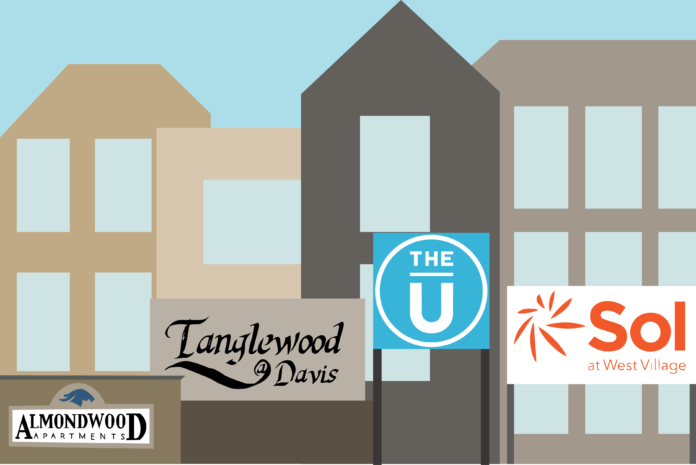Survey shows increase in vacancy rates of apartments, average rent
Apartments in the City of Davis were more vacant in 2019 than the year before, according to an Apartment Vacancy and Rental Rate Survey commissioned by UC Davis Student Housing and Dining Services. The survey, which was published on Feb. 5, found a slight increase in the combined vacancy of apartments leased by unit and apartments leased by bed, from 0.5% in 2018 to 1% in 2019.
Although both types of apartments experienced an increase in the vacancy rate, the vacancy rate for apartments leased by unit only increased from 0.4% in 2018 to 0.6% in 2019. The vacancy rate for apartments leased by room, however, increased much more dramatically — from 0.7% in 2018 to 3.4 % in 2019.
The Apartment Vacancy and Rental Rate Survey is conducted annually by Student Housing and Dining Services in partnership with BAE Urban Economics, a private real estate consulting firm located in Downtown Davis. Michael Sheehan, the associate vice chancellor for Student Housing, Dining and Divisional Operations, explained that the survey is intended to help UC Davis officials make informed decisions about housing.
“The objective of the survey is to provide information that will help inform planning decisions on campus and throughout the broader Davis area,” Sheehan wrote via email. “For example, survey results help campus officials assess the current housing market conditions faced by UC Davis students, faculty, and staff. The survey results also help the university to assess the likely feasibility of proposed campus housing projects.”
UC Davis is currently working on several projects aimed at expanding housing options for students. Recent on-campus housing developments include the opening of Yosemite Hall last fall and the addition of the Latitude dining hall in the Tercero Residence area. The university is also working on expanding housing options for continuing students with the development of The Green at West Village, which is on track to have 3,300 beds by fall 2021, according to Sheehan.
These projects are a part of a housing plan established in a 2018 memorandum of understanding between UC Davis, the City of Davis and Yolo County. In fall 2019, a Joint Annual Housing Report issued by UC Davis, the City of Davis and Yolo County outlined the progress made in adhering to the memorandum of understanding through the construction of housing on campus and within the city. The report also explained why low vacancy rates are a reason for these endeavors.
“Policy responses to the low vacancy rates have included new City of Davis rental registration requirements adopted by the City of Davis and approval of new housing construction by both the City of Davis and UC Davis,” the report reads.
Sheehan specified the upcoming goals emphasized in the memorandum of understanding (MOU).
“Within the MOU there are targets to house more students on-campus,” Sheehan wrote. “We have met the 2019 target of 10,500 beds and we are on track to meet the 2021 target of 12,500 beds and 2023 target of 15,000 beds.”
The efforts to increase available housing is aimed at controlling the blended rental rate for units and bed leases, which experienced an overall increase of 5.5% since 2018. As mentioned in the Joint Annual Housing Report, low vacancy rates can cause, “property owners to sell properties at higher than regional averages and to charge yearly rental rate increases that could exceed typical inflation rates.”
Sheehan addressed the steps UC Davis is taking toward reducing rental rate prices.
“The rent increases in the market are a concern,” Sheehan wrote. “It is an intended outcome that rent increases will be better controlled once greater on-campus inventory has an impact on the overall vacancy rate.”
UC Davis is also working toward developing more resources for students who live off-campus, according to Sheehan.
“Additionally, UC Davis is in the process of creating a basic needs advocate position to liaise with property managers and help resolve student-landlord issues, and support housing and food security efforts on campus,” Sheehan wrote.
Overall, the MOU and the Joint Annual Housing Report are an important example of campus, city and county collaboration on student issues. Matt Dulcich, the Local Government Relations Manager at UC Davis, mentioned the potential of future collaboration between UC Davis and local government.
“The recent collaborative efforts for student housing will hopefully be a model for future projects such as transportation, homelessness services, and many others,” Dulcich wrote via email.
Written by: Madeleine Payne — city@theaggie.org




